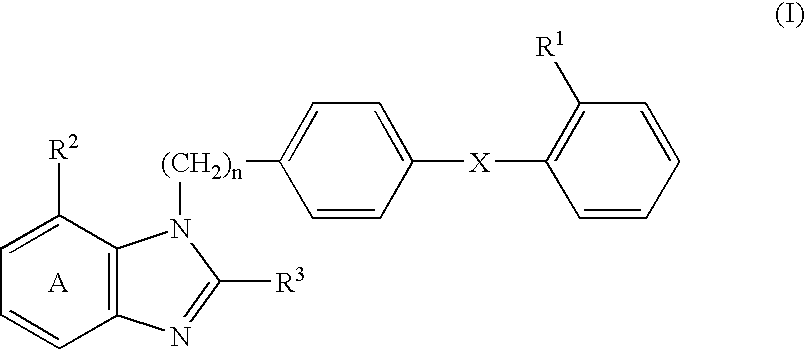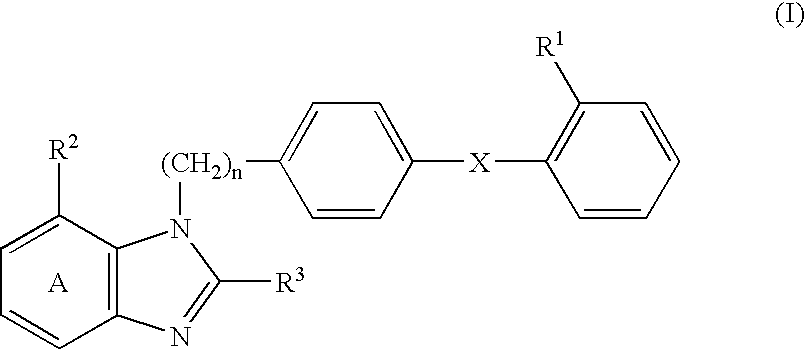Then, use of an antihypertensive is restricted in principle, unless complications with severe hypertension and organ disorders attributable to hypertension such as
heart failure are present.
In the case of cerebral hemorrhage, however, there is danger of increasing
hematocele, and thus about 20% reduction in
blood pressure is often recommended, and in the case of
subarachnoid hemorrhage, an increase in blood pressure causes re-bleeding and significantly influences the prognosis of life, and thus a durable depression in blood pressure is required.
However, there is no report suggesting that a compound having an AII antagonistic activity can be used in a
direct measure for preventing recurrence of cerebrovascular disorder or for ameliorating troubles following cerebrovascular disorder and inhibiting progress thereof.
While treatment at an
acute stage is the most important for treatment of cerebrovascular disorder from the viewpoint of medical economy, prevention of recurrence thereof and its progress are also major problems.
However, only an antiplatelet is used for preventing recurrence of cerebrovascular disorder, and its usefulness is low.
The most dangerous factor for cerebrovascular disorder is hypertension, while the dangerous factors for
cerebral infarction include an
abnormality of
sugar resistance and an
abnormality in electrocardiogram, and the dangerous factors for cerebral hemorrhage include an
abnormality in electrocardiogram, an abnormality in eye ground and drinking, and the like.
However, usually hypertension accompanying cerebral apoplexy causes complications with diabetes, hyperlipemia and
obesity, and accompanies high rates of vascular lesions in hearts, kidneys and
peripheral arteries, and in such conditions, a presently existing antihypertensive therapy does not necessarily prevent the recurrence of cerebral apoplexy.
This is because, in
cerebral infarction after the onset, it is considered that cerebral arteriosclerotic lesions also proceed, and conventional antihypertensives cannot be expected to ameliorate such vascular lesions.
Further, at a
chronic stage of 1 month or more after the onset of
disease conditions, wherein antihypertensive therapy is usually initiated, the upper and lower limits of automatic regulation ability are deviated rightward (toward higher
blood pressure level) in old men or patients with hypertension and cerebrovascular disorder, so even a slight depression in blood pressure causes a reduction in
cerebral blood flow, to cause recurrence of cerebral
ischemia.
Further, patients with hypertension and cerebrovascular disorder often exhibit a non-
dipper where blood pressure at night is increased even by administration of an antihypertensive, or an extra-
dipper where blood pressure at night is too lowered, and hypertension is caused in early
morning, and this change in blood pressure serves as a cause for inducing recurrence of cerebral apoplexy.
However, these drugs have problems with significant depression in blood pressure, duration of their action, and their side effects, and at present there is no ideal
drug.
However, the
ACE inhibitor has the activity of not only inhibiting AII production but also decomposing inflammatory mediators such as
bradykinin and substance P, and because of coughs and vascular edemas resulting therefrom, administration of the
drug should inevitably be terminated in many cases.
Further, at present, there are little drugs (excellent in T / P ratio) showing stable depression in blood pressure through 24 hours, and in patients exhibiting a non-
dipper having recurrence of cerebrovascular disorder at
high rate or patients exhibiting hypertension in early
morning, sufficiently stable depression in blood pressure cannot be achieved.
Further, it is reported that
Candesartan, i.e. an
active metabolite of
Candesartan cilexetil can deviate the
lower limit of automatic regulation leftward (toward
lower blood pressure level) (Vraamark T et al., J Hypertens 13:755-761, 1995), but there is no report suggesting that a compound having AII antagonistic activity is useful as an agent for preventing recurrence of cerebrovascular disorder or as an agent for ameliorating troubles following cerebrovascular disorder and inhibiting progress thereof.
 Login to View More
Login to View More 


